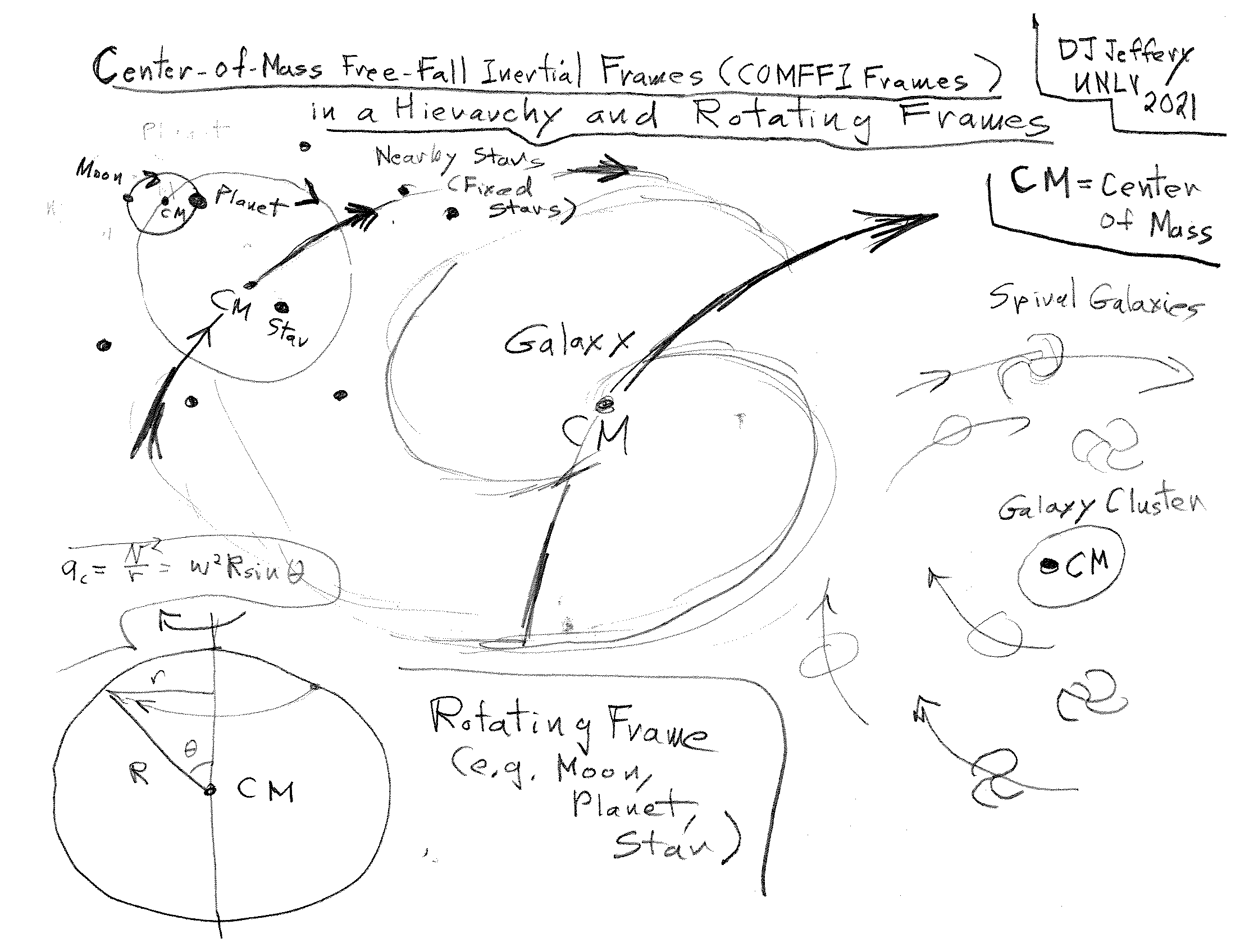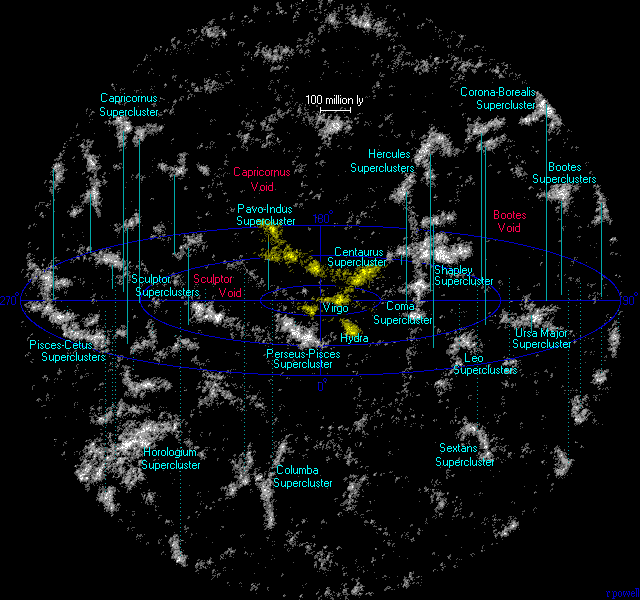
Image 1 Caption: A cartoon illustrating the nested hierarchy of (astrophysical) center-of-mass (CM) inertial frames (called center-of-mass free-fall inertial frames in the cartoon) in the observable universe and an astrophysical rotating frame (attached to, e.g., a moon, planet or star). In our discussion below, we do NOT consider rotating frames. For those, see the Mechanics files: frame_rotating.html and frame_inertial_free_fall.html.
In this figure, we explicate (astrophysical) CM inertial frames and their largest special case comoving frames which are NOT illustrated in the cartoon in Image 1, but of which there is an example in Image 2 below.
Features:
- An astrophysical
CM inertial frame
is just a
CM inertial frame
used to analyze the motions of
systems of
astro-bodies
(i.e., the motions of their
centers of mass).
Usually the only ordinary EXTERNAL and INTERNAL
force
is gravity.
Note, CM inertial frame is often used as a natural synonym for the system of astro-bodies it is used to analyze.
- The EXTERNAL gravitational field
determines the motion of
center of mass
of the system
and tidal forces.
- Usually,
CM inertial frames
are chosen to be
gravitationally-bound systems
simply because those
are ones that tell you most about how the astrophysical realm works.
And you can usually analyze a
CM inertial frame
with only limited knowledge about its environoment, which it why it is convenient to use them
in analysis.
- There is a whole
nested hierarchy of useful
CM inertial frames
all of which are
gravitationally-bound systems,
except comoving frames.
Many
CM inertial frames
of one level are nested in one
CM inertial frame
of the next level.
The center of mass
motion of any
CM inertial frame
is analyzed in the
CM inertial frame
of the next level it is nested in.
The hierarchy is illustrated in Image 1 and is specified (NOT exhaustively) as follows: - planet-moon systems: e.g., the Earth-Moon system.
- planetary systems: e.g., the Solar System.
- star clusters: Note many planetary systems are NOT in star clusters: e.g., the Solar System.
- galaxies: e.g., Milky Way.
- galaxy clusters (e.g., the Virgo Cluster) and galaxy groups (e.g., the Local Group (of Galaxies)). Note a galaxy NOT in a galaxy cluster or galaxy group is a field galaxy.
- A comoving frame
is any spherical region in
space large enough
to obey the
cosmological principle:
i.e., its size-scaleless
properties (e.g., density,
distribution of
galaxy types,
expansion of the universe
behavior)
are close to the average
of the whole
observable universe.
The center of mass
of the spherical region is its geometrical center since
the spherical region is assumed to have nearly UNIFORM
density.
How large does the spherical region have to be?
Current thinking is that its size scale has to be ⪆
370 megaparsecs Mpc
(∼ 1000 Mly = 1 Gly)
(Wikipedia:
Violations of homogeneity;
Sawala et al. 2025).
This size scale can be called the
Yadav scale
after the lead author of the paper which specified it.

- Image 2 Caption: A map of the large-scale structure of the universe of the local universe out to ∼ 300 Mpc = 0.30 Gpc (∼ 2 % of the observable universe radius = 14.3 Gpc) from the center at the unlabeled Milky Way: i.e., to cosmological redshift z ≅ 0.07 and lookback time ≅ 1 Gyr.
The Laniakea Supercluster is marked in yellow in Image 2.
- The spherical region in Image 2 is our comoving frame: i.e., the comoving frame centered on us: "us" being any of the Solar System, the Milky Way, and the Local Group. It is of order the Yadav scale: i.e., ⪆ 370 Mpc.
- Using measurement of the cosmic microwave background (CMB, T = 2.72548(57) K (Fixsen 2009)), we can, in fact, determine our peculiar velocities relative to the center of mass of our comoving frame (which is where we are in our comoving frame). The center of mass itself just participates in the mean expansion of the universe.
Our peculiar velocities:
- The
Solar System center of mass
(i.e., center of mass
of the Solar System)
is moving at 368(2) km/s in some direction
(see
Wikipedia: CMB dipole anisotropy (ℓ=1);
Caltech:
Description of CMB Anisotropies).
- The Milky Way
center of mass
is moving at 552(6) km/s in the direction
10.5 hours right ascension (RA),
0.24° declination (Dec or δ) in
equatorial coordinates
(epoch J2000)
which is toward near the center of
constellation
Hydra
(see Wikipedia: Milky Way: Velocity).
- Local Group of Galaxies
center of mass
is moving
at 627(22) km/s in some direction
(see
Wikipedia: CMB dipole anisotropy (ℓ=1);
Caltech:
Description of CMB Anisotropies).
- Galaxy superclusters (e.g., those seen in Image 2) are NOT gravitationally bound systems in general. This means they will be pulled apart eventually by the expansion of the universe. Galaxy superclusters are generally NOT analyzed using CM inertial frames but in computer simulations of structure formation (AKA large-scale structure formation).
-
Images:
- Credit/Permission: ©
David Jeffery,
2021 / Own work.
Image link: Itself.
- Credit/Permission: ©
Richard Powell
2016
(uploaded to Wikipedia
by User:AdAstraPerScientiam,
2009) /
Creative Commons
CC BY-SA 2.5.
Image link: Wikimedia Commons: File:Laniakea.gif.
- Credit/Permission: ©
David Jeffery,
2004 / Own work.
Image link: Itself.
Extended file: Mechanics file: frame_hierarchy_astro_4.html.
File: Mechanics file: frame_hierarchy_astro.html.